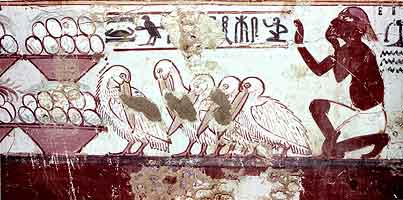|
||||||||||||||||
|
|
||||||||||||||||
|

Humans, Nature and Birds |
From Room 2: Birds as Resources for Human Use |
||||
|
|||||
 Plate 12 |
The pelican is said to have represented protection against snakes and safe passage after death, but since the chief fowler accompanies the pelicans here, perhaps they represent a valued resource for Horemheb in the underworld. If so, the image also suggests that pelicans were domesticated--which would be surprising. The domestication of birds there is a very old practice, one that even predates the dynasties, and ancient images show the use of herons as decoys to attract wetland birds into open traps, and the force-feeding of cranes and waterfowl. But the decision to feature pelicans (Pelecanus sp.) and their eggs in a tomb is puzzling. The pelican is said to have represented protection against snakes and safe passage after death, but since the chief fowler accompanies the pelicans here, perhaps they represent a valued resource for Horemheb in the underworld. If so, the image also suggests that pelicans were domesticated--which would be surprising. Ducks, geese, pigeons, quails, and occasional chickens--all of which breed rapidly--were the principal domesticated fowl in ancient Egypt. It seems odd that the Egyptians would also choose to domesticate pelicans, which ordinarily lay only two eggs in each breeding season. But here is a fowler, apparently a person with an official function, superintending a group of pelicans. Pelicans are excellent fish catchers; perhaps some ancient page 3--> |
||||
| Plate 12 Pelicans from a Wall Painting n the Tomb of Horemheb [untitled wall painting no. 78], (detail), Thebes, Egypt, early 1400s BCE Photo credit: George Hughes. Courtesy of the Oriental Institute of the University of Chicago. © 2008 Darryl Wheye and Donald Kennedy |
|||||